Journal of Southern Medical University ›› 2024, Vol. 44 ›› Issue (8): 1518-1528.doi: 10.12122/j.issn.1673-4254.2024.08.10
Previous Articles Next Articles
Shanyuan ZHANG1( ), Qiaoyan CAI1,2,4(
), Qiaoyan CAI1,2,4( ), Jianghan QI1, Kaixin YIN3, Chenchen HE1, Zhuye GAO5, Ling ZHANG1,2,4(
), Jianghan QI1, Kaixin YIN3, Chenchen HE1, Zhuye GAO5, Ling ZHANG1,2,4( ), Jianfeng CHU1,2,4(
), Jianfeng CHU1,2,4( )
)
Received:2024-05-17
Online:2024-08-20
Published:2024-09-06
Contact:
Ling ZHANG, Jianfeng CHU
E-mail:shanyuanzhang66@gmail.com;cqy2005899@163.com;remona1986@126.com;jianfengchu@126.com
Shanyuan ZHANG, Qiaoyan CAI, Jianghan QI, Kaixin YIN, Chenchen HE, Zhuye GAO, Ling ZHANG, Jianfeng CHU. Pharmacodynamics of Qingxin Jieyu Granules for treatment of atherosclerosis and its regulatory mechanism for lipid metabolism[J]. Journal of Southern Medical University, 2024, 44(8): 1518-1528.
Add to citation manager EndNote|Ris|BibTeX
URL: https://www.j-smu.com/EN/10.12122/j.issn.1673-4254.2024.08.10
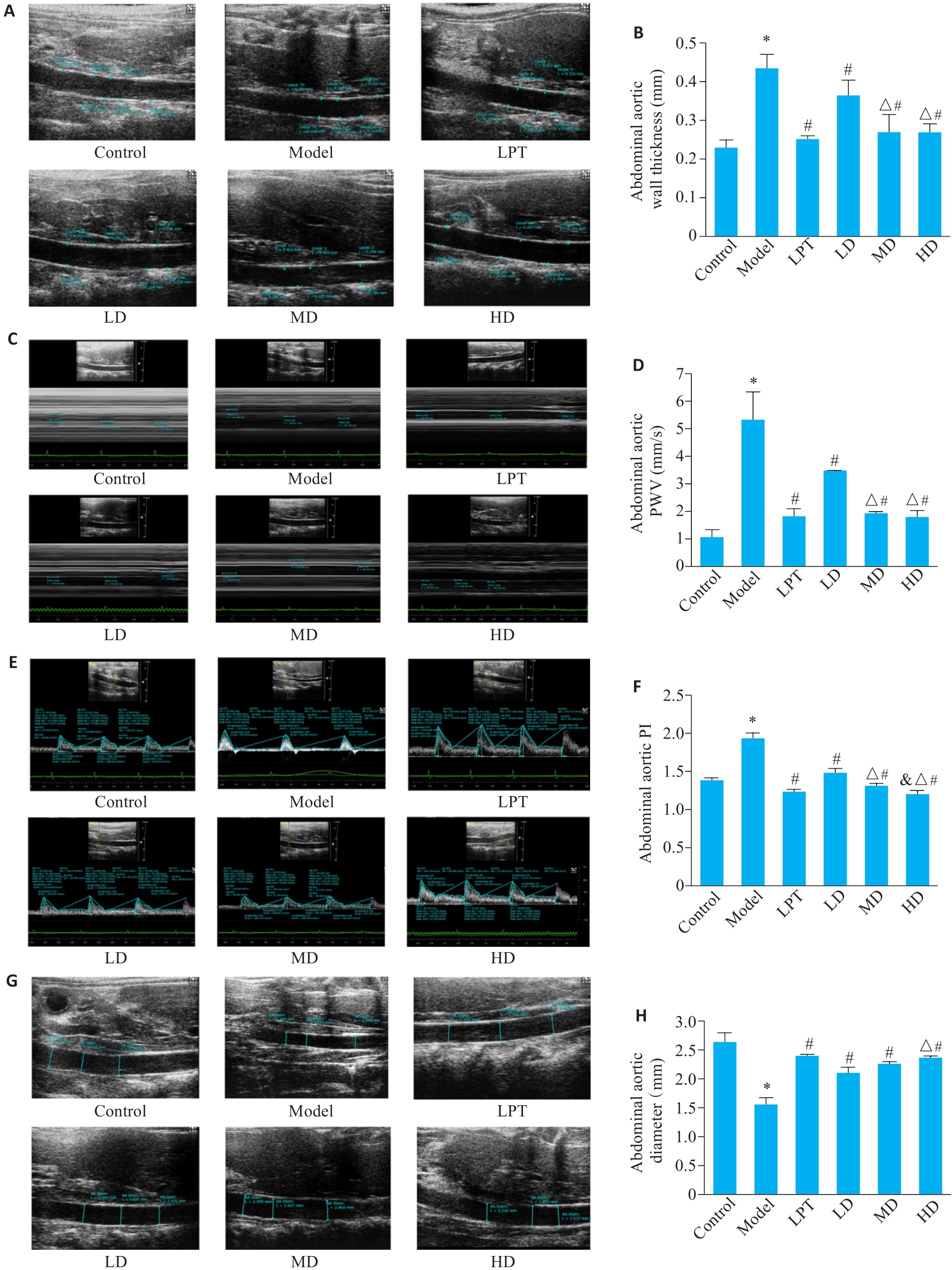
Fig.1 Effects of QXJYG on vessel wall thickness, pulse wave propagation velocity, pulsatility index and vessel diameter in atherosclerotic rats. A, B: Ultrasound images and quantitative comparison of wall thickness of the abdominal aorta. C, D: Sonograms and quantitative comparison of pulse-wave propagation velocity of the abdominal aorta. E, F: Echocardiograms and quantitative analysis of the pulsatility index of the abdominal aorta. G, H: Ultrasound images and quantitative analysis of abdominal aorta vessel diameter. LPT: Positive control (atorvastatin) group; LD: Low-dose QXJYG group; MD: Medium-dose QXJYG group; HD: High-dose QXJYG group. *P<0.05 vs Control group; #P<0.05 vs Model group; △P<0.05 vs LD group; &P<0.05 vs MD group.
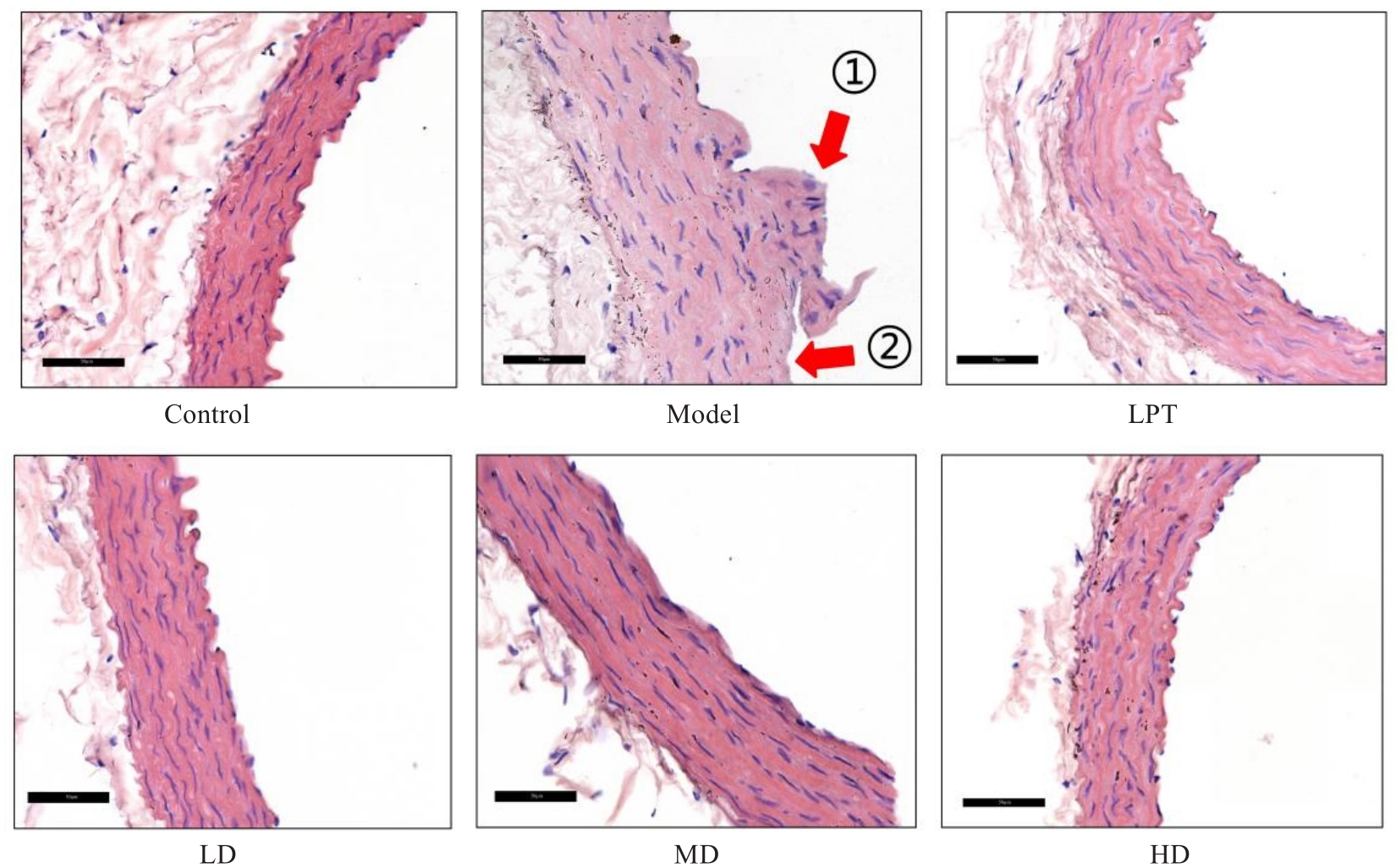
Fig.2 Effects of QXJYG on vascular pathology of the abdominal aorta in rats with atherosclerosis (HE staining, Scale bar=50 µm).①Intimal thickening of the blood vessels; ②Proliferation of smooth muscle cells with disordered arrangement.

Fig.3 Effects of QXJYG on serum levels of TC, LDL-C, TG and HDL-C in rats with atherosclerosis. A: Serum levels of TC and LDL-C. B: Serum levels of TG and HDL-C. *P<0.05 vs Control group; #P<0.05 vs Model group; △P<0.05 vs LD group.
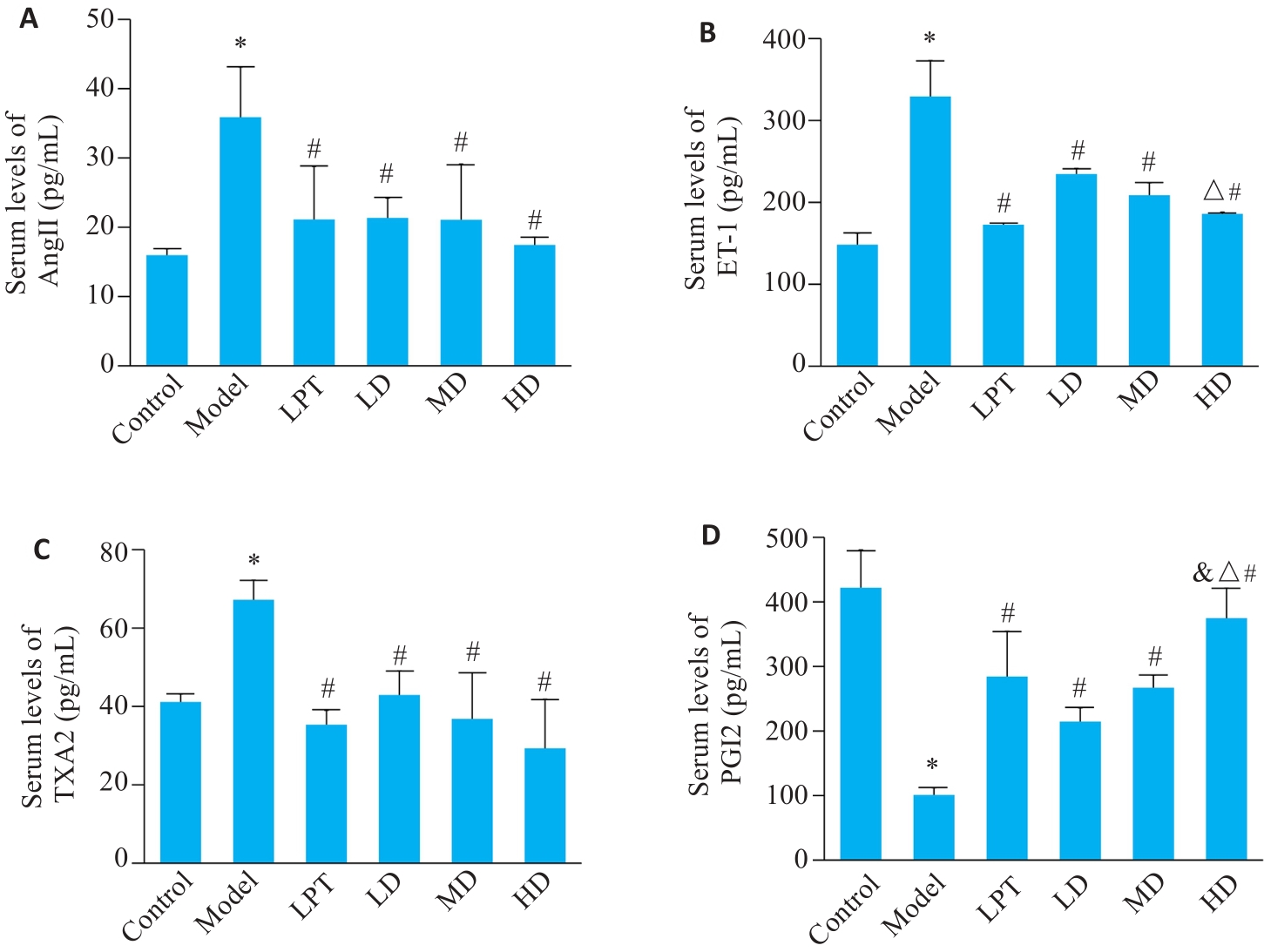
Fig.4 Effects of QXJYG on serum levels of Ang II (A), ET-1 (B), TXA2 (C) and PGI2 (D) in rats with atherosclerosis. *P<0.05 vs Control group; #P<0.05 vs Model group; △P<0.05 vs LD group; &P<0.05 vs MD group.
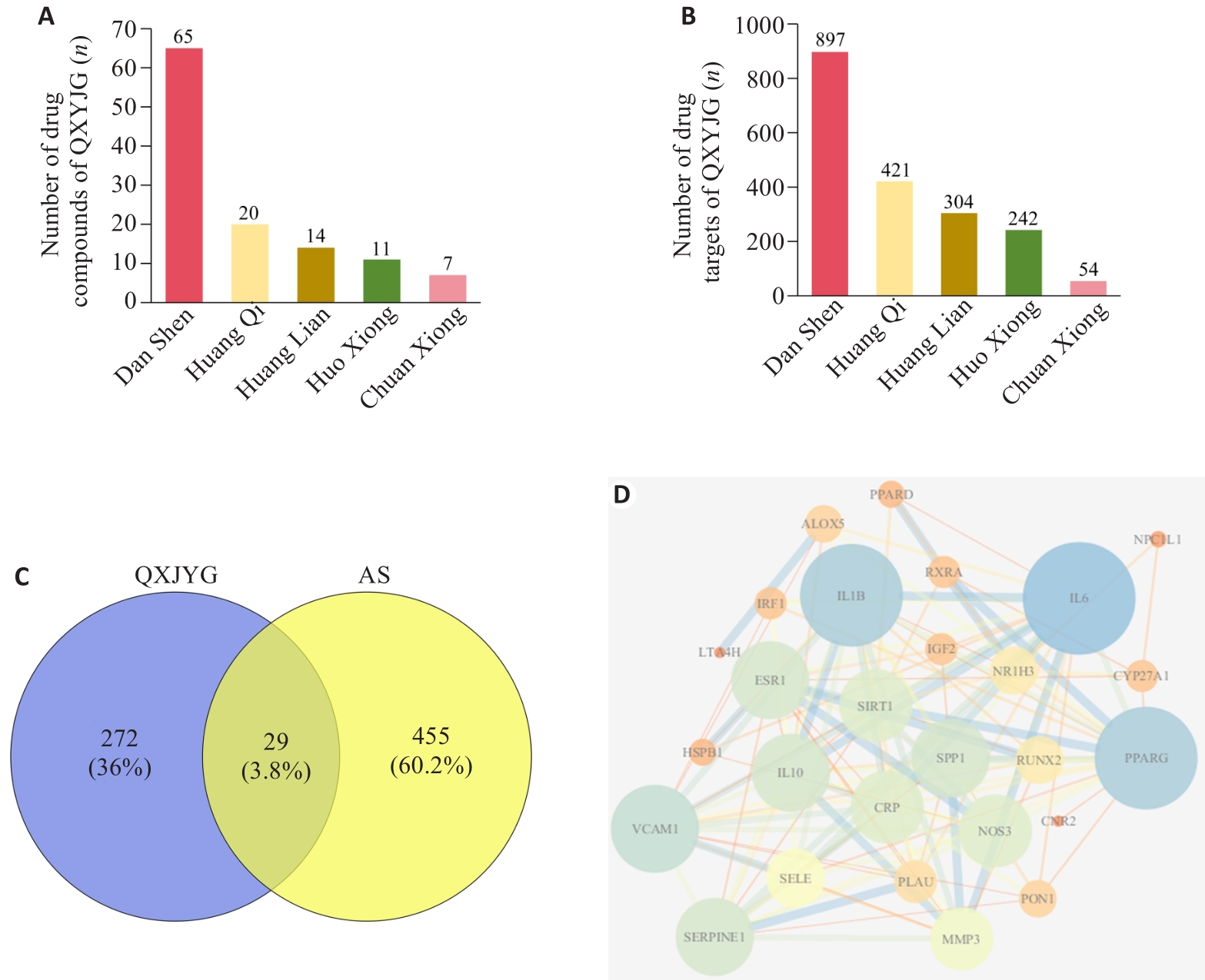
Fig.5 Analysis of targets of QXJYG and AS. A: Quantity diagram of each drug compound of QXJYG. B: Number of drug targets of QXJYG. C: Venn diagram of QXJYG and AS targets. D: PPI plot of potential protein interaction of QXJYG against AS.
| Key target | Degree | Betweenness centrality | Closeness centrality |
|---|---|---|---|
| IL-6 | 21 | 0.14771628 | 0.83870968 |
| IL-1B | 19 | 0.0880959 | 0.78787879 |
| PPARG | 19 | 0.20820912 | 0.78787879 |
| VCAM1 | 16 | 0.03766667 | 0.7027027 |
| IL-10 | 14 | 0.02131169 | 0.66666667 |
| SERPINE1 | 14 | 0.01293806 | 0.65 |
| ESR1 | 14 | 0.04946542 | 0.65 |
| SPP1 | 14 | 0.01452414 | 0.65 |
| CRP | 13 | 0.00772194 | 0.63414634 |
| SIRT1 | 13 | 0.04028405 | 0.65 |
| NOS3 | 13 | 0.01529604 | 0.63414634 |
| MMP3 | 11 | 0.00423576 | 0.57777778 |
| SELE | 10 | 0.00117216 | 0.59090909 |
Tab.1 Cross targets of QXJYG with anti-AS values higher than the average value
| Key target | Degree | Betweenness centrality | Closeness centrality |
|---|---|---|---|
| IL-6 | 21 | 0.14771628 | 0.83870968 |
| IL-1B | 19 | 0.0880959 | 0.78787879 |
| PPARG | 19 | 0.20820912 | 0.78787879 |
| VCAM1 | 16 | 0.03766667 | 0.7027027 |
| IL-10 | 14 | 0.02131169 | 0.66666667 |
| SERPINE1 | 14 | 0.01293806 | 0.65 |
| ESR1 | 14 | 0.04946542 | 0.65 |
| SPP1 | 14 | 0.01452414 | 0.65 |
| CRP | 13 | 0.00772194 | 0.63414634 |
| SIRT1 | 13 | 0.04028405 | 0.65 |
| NOS3 | 13 | 0.01529604 | 0.63414634 |
| MMP3 | 11 | 0.00423576 | 0.57777778 |
| SELE | 10 | 0.00117216 | 0.59090909 |
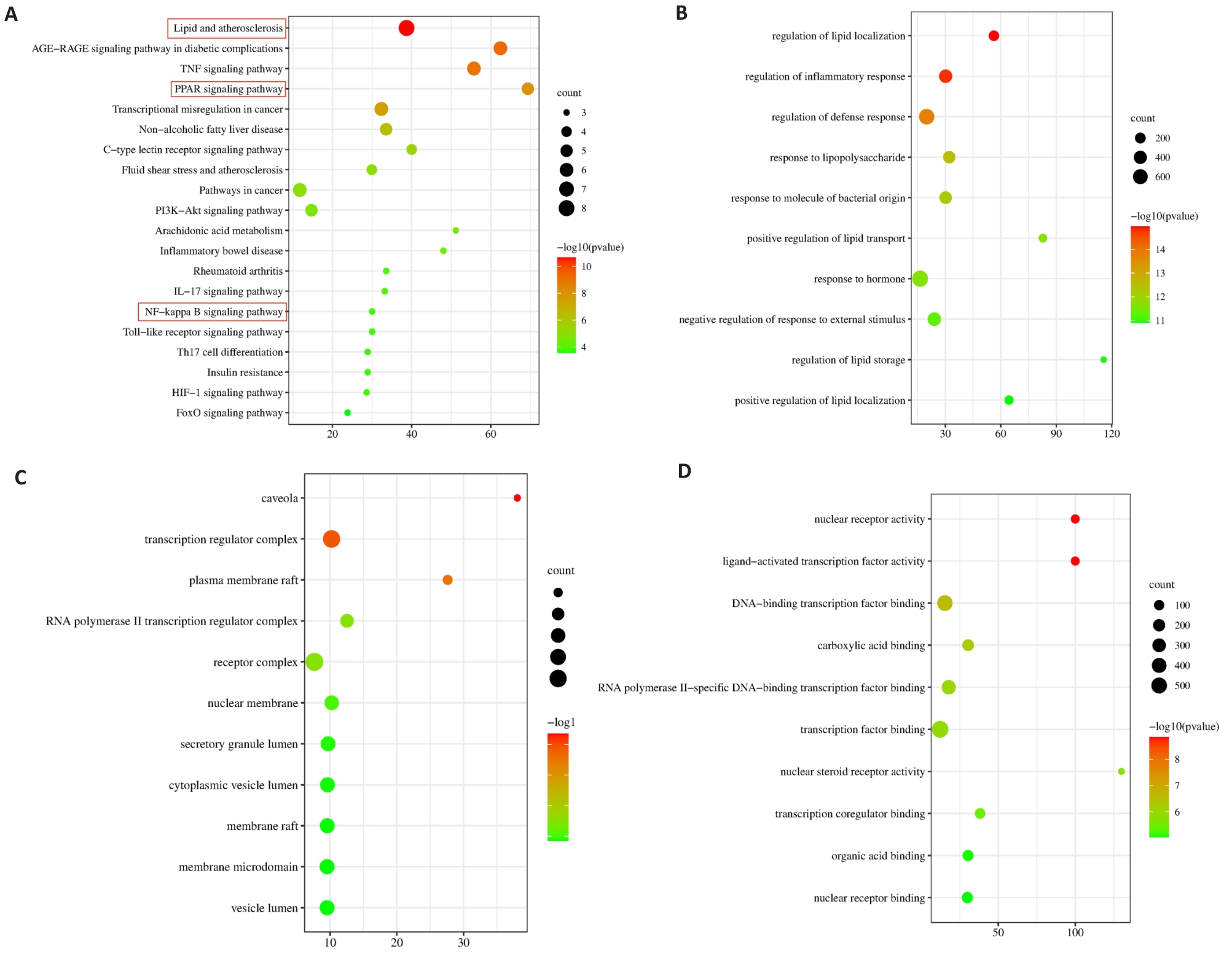
Fig.6 KEGG pathway enrichment analysis and GO functional analysis of QXJYG against AS.A: KEGG pathway enrichment analysis of QXJYG against AS. B: Biological processes analysis of QXJYG against AS. C: Cell components analysis of QXJYG against AS. D: Molecular function analysis of QXJYG against AS.
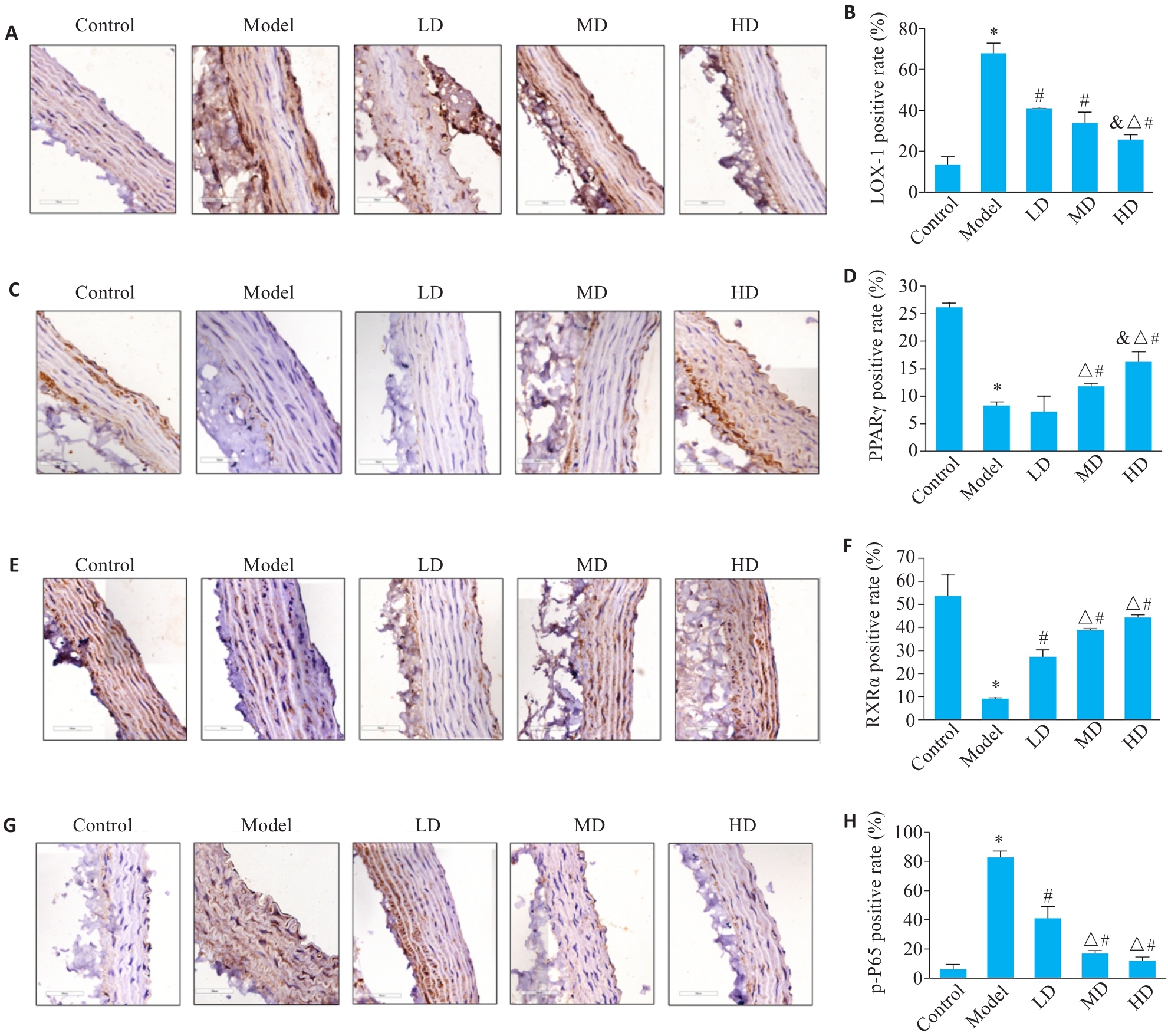
Fig.8 Effect of QXJYG on the expression of LOX-1, PPARγ, RXRα and p-P65 in the abdominal aorta of atherosclerotic rats (DAB staining, original magnification: ×400). A, B: LOX-1 expression and positivity rate in the abdominal aorta. C, D: PPARγ expression and positivity rate in the abdominal aorta. E, F: Expression of RXRα and positivity rate positive rate. G, H: Expression of p-P65 and positivity rate. *P<0.05 vs Control group; #P<0.05 vs Model group; △P<0.05 vs LD group; &P<0.05 vs MD group.
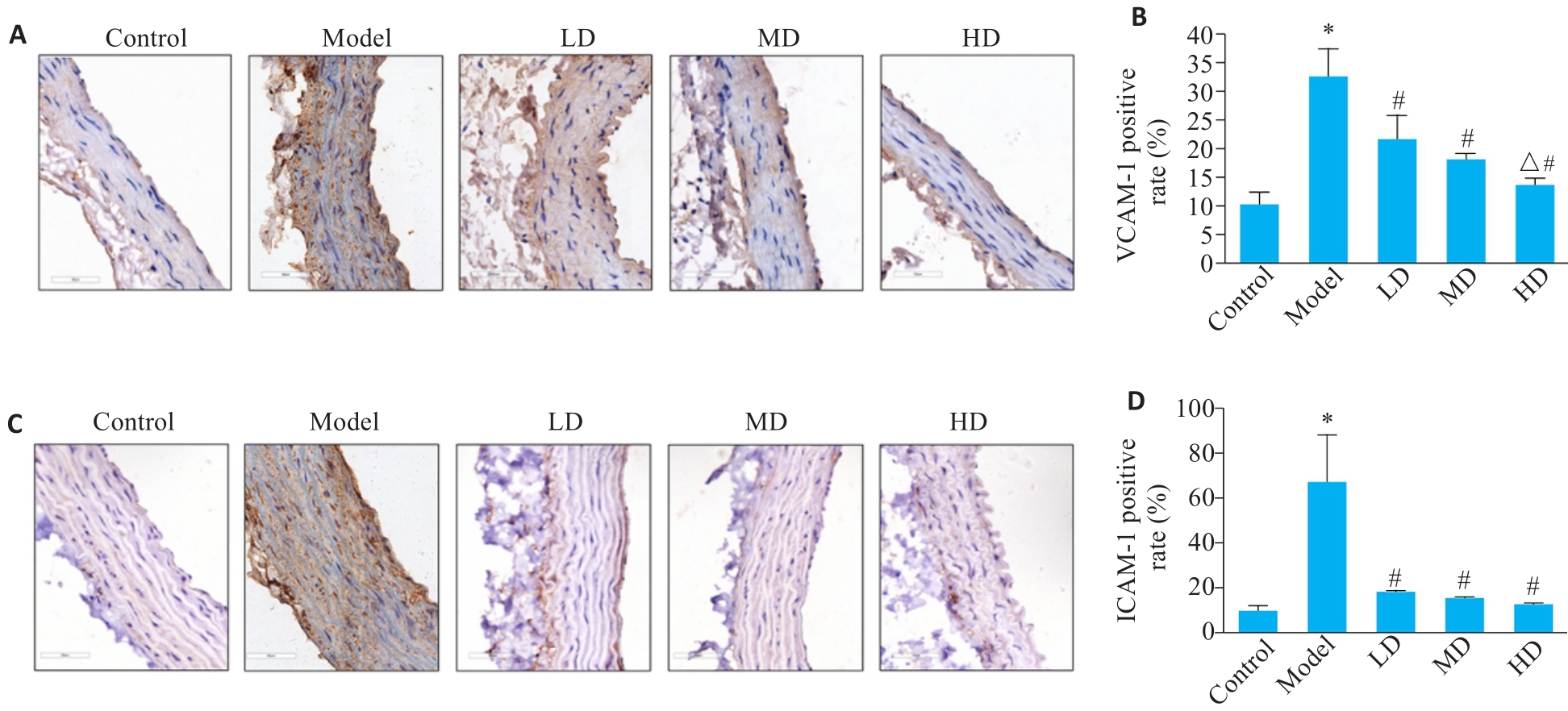
Fig.9 Effect of QXJYG on the expression of VCAM-1 and ICAM-1 in abdominal aorta of atherosclerotic rats (DAB staining, ×400). A, B: VCAM-1 expression and positivity rate in the abdominal aorta. C, D: ICAM-1 expression and positivity rate in the abdominal aorta. *P<0.05 vs Control group; #P<0.05 vs Model group; △P<0.05 vs LD group.
| 1 | 马丽媛, 王增武, 樊 静, 等. 《中国心血管健康与疾病报告2022》要点解读[J]. 中国全科医学, 2023, 9(32): 3975-94. |
| 2 | 赵 冬. 新中国成立70年来我国人群血脂流行病学研究回顾与进展[J]. 中国医药, 2019, 14(10): 1441-4. |
| 3 | 王吉耀. 内科学[M]. 2版. 北京: 人民卫生出版社, 2010: 267-74. |
| 4 | Ibanez B, Fernández-Ortiz A, Fernández-Friera L, et al. Progression of early subclinical atherosclerosis (PESA) study: JACC focus seminar 7/8[J]. J Am Coll Cardiol, 2021, 78(2): 156-79. |
| 5 | Yin LQ, Wang LH, Shi ZH, et al. The role of peroxisome proliferator-activated receptor gamma and atherosclerosis: post-translational modification and selective modulators[J]. Front Physiol, 2022, 13: 826811. |
| 6 | Gao LN, Zhou X, Lu YR, et al. Dan-Lou prescription inhibits foam cell formation induced by ox-LDL via the TLR4/NF-κB and PPARγ signaling pathways[J]. Front Physiol, 2018, 9: 590. |
| 7 | 李银花, 贾张蓉, 江 龙, 等. 血脂康对冠心病合并高脂血症患者疗效的Meta分析[J]. 中国循证心血管医学杂志, 2014, 6(1): 25-30. |
| 8 | Zhang Z, Gao J, Wang J, et al. Mechanism of Zhishi Xiebai Guizhi decoction to treat atherosclerosis: Insights into experiments, network pharmacology and molecular docking. J Ethnopharmacol, 2024, 333: 118466. |
| 9 | Zhi W, Liu Y, Wang X, et al. Recent advances of traditional Chinese medicine for the prevention and treatment of atherosclerosis[J]. J Ethnopharmacol, 2023, 301: 115749. |
| 10 | 李圣耀, 杨 琳, 高铸烨, 等. 清心解瘀方组方中药入血成分的网络药理学分析[J]. 中国实验方剂学杂志, 2018, 24(5): 198-202. |
| 11 | 高 翔. 清心解瘀方干预炎症反应增强的稳定性冠心病患者临床研究[D]. 北京: 中国中医科学院, 2017. |
| 12 | 李金根. 清心解瘀方对稳定性冠心病临床终点事件影响的随机双盲对照研究[D]. 北京: 北京中医药大学, 2018. |
| 13 | 鞠建庆. 清心解瘀方调控巨噬细胞焦亡稳定动脉粥样硬化易损斑块的机制研究[D]. 北京: 北京中医药大学, 2019. |
| 14 | Zhang J, Wang XY, Guan BY, et al. Qing-Xin-Jie-Yu Granule inhibits ferroptosis and stabilizes atherosclerotic plaques by regulating the GPX4/xCT signaling pathway[J]. J Ethnopharmacol, 2023, 301: 115852. |
| 15 | Wang AL, Guan BY, Shao C, et al. Qing-Xin-Jie-Yu Granule alleviates atherosclerosis by reshaping gut microbiota and metabolic homeostasis of ApoE-/- mice[J]. Phytomedicine, 2022, 103: 154220. |
| 16 | Zhu ZS, Li JY, Zhang XR. Astragaloside IV protects against oxidized low-density lipoprotein (ox-LDL)-induced endothelial cell injury by reducing oxidative stress and inflammation[J]. Med Sci Monit, 2019, 25: 2132-40. |
| 17 | Zhang YF, Feng XT, Du M, et al. Salvianolic acid B attenuates the inflammatory response in atherosclerosis by regulating MAPKs/NF-κB signaling pathways in LDLR-/- mice and RAW264.7 cells[J]. Int J Immunopathol Pharmacol, 2022, 36: 3946320221079468. |
| 18 | 李洪涛, 邓 宇, 王添乐, 等. 丹参新醌乙减轻ox-LDL诱导的内皮细胞损伤: 基于抑制NF-κB/NLRP3信号通路介导的细胞焦亡[J]. 南方医科大学学报, 2023, 9(8): 1425-31. |
| 19 | Li L, Chen HW, Shen AL, et al. Ligustrazine inhibits platelet activation via suppression of the Akt pathway[J]. Int J Mol Med, 2019, 43(1): 575-82. |
| 20 | Zhuang Z, Wang ZH, Huang YY, et al. Protective effect and possible mechanisms of ligustrazine isolated from Ligusticum wallichii on nephropathy in rats with diabetes: a preclinical systematic review and meta-analysis[J]. J Ethnopharmacol, 2020, 252: 112568. |
| 21 | 张 伟, 张娟娟, 郭庆丰, 等. 广藿香醇药理作用研究进展[J]. 中国实验方剂学杂志, 2020, 26(3): 213-21. |
| 22 | Zhao JV, Yeung WF, Chan YH, et al. Effect of berberine on cardiovascular disease risk factors: a mechanistic randomized controlled trial[J]. Nutrients, 2021, 13(8): 2550. |
| 23 | Song T, Chen WD. Berberine inhibited carotid atherosclerosis through PI3K/AKTmTOR signaling pathway[J]. Bioengineered, 2021, 12(1): 8135-46. |
| 24 | 陈 超, 张瑞芬, 张海荣. PPAR-γ与动脉粥样硬化及其危险因素的相关研究进展[J]. 中国循证心血管医学杂志, 2021, 13(9): 1146-7. |
| 25 | 樊碧娆, 姚伟娟. 氧化型低密度脂蛋白受体在动脉粥样硬化发病机制中的作用[J]. 中国病理生理杂志, 2020, 36(10): 1897-901. |
| 26 | Yang XF, Shang DJ. The role of peroxisome proliferator-activated receptor γ in lipid metabolism and inflammation in atherosclerosis[J]. Cell Biol Int, 2023, 47(9): 1469-87. |
| 27 | 汤银娟, 王建钧, 关莹露, 等. 阿托伐他汀对高胆固醇血症大鼠侧支血管中LOX-1和eNOS表达的影响[J]. 南方医科大学学报, 2019, 39(11): 1265-72. |
| 28 | Tang H, Zeng QF, Tang T, et al. Kaempferide improves glycolipid metabolism disorder by activating PPARγ in high-fat-diet-fed mice[J]. Life Sci, 2021, 270: 119133. |
| 29 | Zhang BH, Hao ZW, Zhou WL, et al. Formononetin protects against ox-LDL-induced endothelial dysfunction by activating PPAR‑γ signaling based on network pharmacology and experimental validation[J]. Bioengineered, 2021, 12(1): 4887-98. |
| 30 | Guo H, Cui BD, Gong M, et al. An ethanolic extract of Arctium lappa L. leaves ameliorates experimental atherosclerosis by modulating lipid metabolism and inflammatory responses through PI3K/Akt and NF‑κB singnaling pathways[J]. J Ethnopharmacol, 2024, 325: 117768. |
| 31 | Ebrahimi F, Ghazimoradi MM, Fatima G, et al. Citrus flavonoids and adhesion molecules: potential role in the management of atherosclerosis[J]. Heliyon, 2023, 9(11): e21849. |
| 32 | Adam CA, Șalaru DL, Prisacariu C, et al. Novel biomarkers of atherosclerotic vascular disease-latest insights in the research field[J]. Int J Mol Sci, 2022, 23(9): 4998. |
| [1] | Xinyuan CHEN, Chengting WU, Ruidi LI, Xueqin PAN, Yaodan ZHANG, Junyu TAO, Caizhi LIN. Shuangshu Decoction inhibits growth of gastric cancer cell xenografts by promoting cell ferroptosis via the P53/SLC7A11/GPX4 axis [J]. Journal of Southern Medical University, 2025, 45(7): 1363-1371. |
| [2] | Liming WANG, Hongrui CHEN, Yan DU, Peng ZHAO, Yujie WANG, Yange TIAN, Xinguang LIU, Jiansheng LI. Yiqi Zishen Formula ameliorates inflammation in mice with chronic obstructive pulmonary disease by inhibiting the PI3K/Akt/NF-κB signaling pathway [J]. Journal of Southern Medical University, 2025, 45(7): 1409-1422. |
| [3] | Yinfu ZHU, Yiran LI, Yi WANG, Yinger HUANG, Kunxiang GONG, Wenbo HAO, Lingling SUN. Therapeutic mechanism of hederagenin, an active component in Guizhi Fuling Pellets, against cervical cancer in nude mice [J]. Journal of Southern Medical University, 2025, 45(7): 1423-1433. |
| [4] | Bing XIA, Jin PENG, Jiuyang DING, Jie WANG, Guowei TANG, Guojie LIU, Yun WANG, Changwu WAN, Cuiyun LE. ATF3 regulates inflammatory response in atherosclerotic plaques in mice through the NF-κB signaling pathway [J]. Journal of Southern Medical University, 2025, 45(6): 1131-1142. |
| [5] | Lijun HE, Xiaofei CHEN, Chenxin YAN, Lin SHI. Inhibitory effect of Fuzheng Huaji Decoction against non-small cell lung cancer cells in vitro and the possible molecular mechanism [J]. Journal of Southern Medical University, 2025, 45(6): 1143-1152. |
| [6] | Guoyong LI, Renling LI, Yiting LIU, Hongxia KE, Jing LI, Xinhua WANG. Therapeutic mechanism of Arctium lappa extract for post-viral pneumonia pulmonary fibrosis: a metabolomics, network pharmacology analysis and experimental verification [J]. Journal of Southern Medical University, 2025, 45(6): 1185-1199. |
| [7] | Liping GUAN, Yan YAN, Xinyi LU, Zhifeng LI, Hui GAO, Dong CAO, Chenxi HOU, Jingyu ZENG, Xinyi LI, Yang ZHAO, Junjie WANG, Huilong FANG. Compound Centella asiatica formula alleviates Schistosoma japonicum-induced liver fibrosis in mice by inhibiting the inflammation-fibrosis cascade via regulating the TLR4/MyD88 pathway [J]. Journal of Southern Medical University, 2025, 45(6): 1307-1316. |
| [8] | Peipei TANG, Yong TAN, Yanyun YIN, Xiaowei NIE, Jingyu HUANG, Wenting ZUO, Yuling LI. Tiaozhou Ziyin recipe for treatment of premature ovarian insufficiency: efficacy, safety and mechanism [J]. Journal of Southern Medical University, 2025, 45(5): 929-941. |
| [9] | Xiaotao LIANG, Yifan XIONG, Xueqi LIU, Xiaoshan LIANG, Xiaoyu ZHU, Wei XIE. Huoxue Shufeng Granule alleviates central sensitization in chronic migraine mice via TLR4/NF-κB inflammatory pathway [J]. Journal of Southern Medical University, 2025, 45(5): 986-994. |
| [10] | Niandong RAN, Jie LIU, Jian XU, Yongping ZHANG, Jiangtao GUO. n-butanol fraction of ethanol extract of Periploca forrestii Schltr.: its active components, targets and pathways for treating Alcheimer's disease in rats [J]. Journal of Southern Medical University, 2025, 45(4): 785-798. |
| [11] | Haonan¹ XU, Fang³ ZHANG, Yuying² HUANG, Qisheng⁴ YAO, Yueqin⁴ GUAN, Hao CHEN. Thesium chinense Turcz. alleviates antibiotic-associated diarrhea in mice by modulating gut microbiota structure and regulating the EGFR/PI3K/Akt signaling pathway [J]. Journal of Southern Medical University, 2025, 45(2): 285-295. |
| [12] | Junjie GAO, Kai YE, Jing WU. Quercetin inhibits proliferation and migration of clear cell renal cell carcinoma cells by regulating TP53 gene [J]. Journal of Southern Medical University, 2025, 45(2): 313-321. |
| [13] | Ying LIU, Borui LI, Yongcai LI, Lubo CHANG, Jiao WANG, Lin YANG, Yonggang YAN, Kai QV, Jiping LIU, Gang ZHANG, Xia SHEN. Jiawei Xiaoyao Pills improves depression-like behavior in rats by regulating neurotransmitters, inhibiting inflammation and oxidation and modulating intestinal flora [J]. Journal of Southern Medical University, 2025, 45(2): 347-358. |
| [14] | Qiao CHU, Xiaona WANG, Jiaying XU, Huilin PENG, Yulin ZHAO, Jing ZHANG, Guoyu LU, Kai WANG. Pulsatilla saponin D inhibits invasion and metastasis of triple-negative breast cancer cells through multiple targets and pathways [J]. Journal of Southern Medical University, 2025, 45(1): 150-161. |
| [15] | Xiupeng LONG, Shun TAO, Shen YANG, Suyun LI, Libing RAO, Li LI, Zhe ZHANG. Quercetin improves heart failure by inhibiting cardiomyocyte apoptosis via suppressing the MAPK signaling pathway [J]. Journal of Southern Medical University, 2025, 45(1): 187-196. |
| Viewed | ||||||
|
Full text |
|
|||||
|
Abstract |
|
|||||